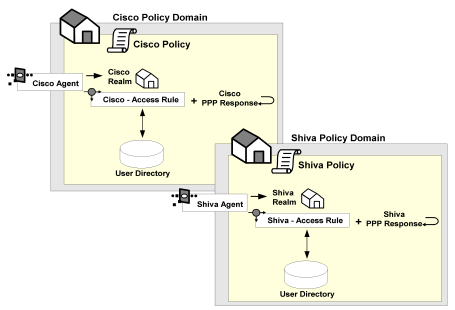

A more powerful and complex deployment of the Policy Server in a RADIUS environment is one that includes multiple realms administered by multiple NAS devices. In this scenario, the Policy Server can serve as the RADIUS authentication server for multiple RADIUS clients at once.
The advantage of using a heterogeneous configuration is that you save time by using the same RADIUS authentication server (that is, the Policy Server) for each RADIUS client.
An example of a heterogeneous configuration is illustrated in the following graphic:

In the network topology shown in the previous diagram, the Policy Server authenticates users of two NAS devices: a Cisco RAS and a Checkpoint Firewall. The Policy Server uses one user directory to authenticate the users.
Each NAS device has its own RADIUS Agent, which has been configured with a realm hint. When the Policy Server receives a request to authenticate the user, it uses the RADIUS Agent’s realm hint to determine the resource (domain) that the authenticated user can access.
The process of authentication when one user directory is used is as follows:
The RAS notifies the Policy Server that the session has begun and when the session ends.
When the Internet user attempts to dial into the Internet Service Provider via the Checkpoint Firewall, a similar process of authentication occurs. Using the realm hint, the RADIUS Agent defined for the Checkpoint Firewall determines which domain the Internet user has access to. If the user is authenticated, the Policy Server passes the Firewall the correct attributes to establish the session.
User information for both NAS devices is stored in the same user directory. Each time the Policy Server receives an authentication request, it authenticates the user using the same data directory.
This system configuration differs from the homogeneous environment; you must now create two Agents.
Within the policy domain there is one policy that includes rules and responses for the Cisco Agent and the Checkpoint Agent.
To setup CA SiteMinder® in the heterogeneous, single directory environment described above, you must:
A diagram of this policy domain is shown in the following graphic:

For this environment, you must configure two RADIUS Agents:
The Policy Server can authenticate users using the same user directory for both NAS devices.
The policy domain must identify the user directory that contains the names of the RADIUS users, the names of the Administrators who can modify the domain, and the realm that the RADIUS Agent is protecting. A RADIUS environment that uses only one user directory requires only one policy domain.
|
Copyright © 2015 CA Technologies.
All rights reserved.
|
|